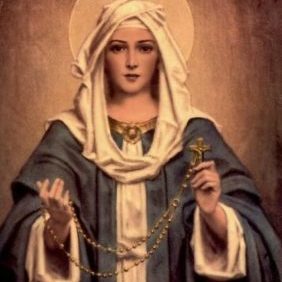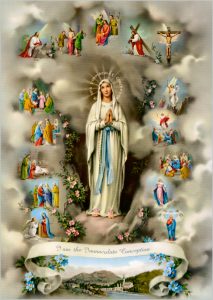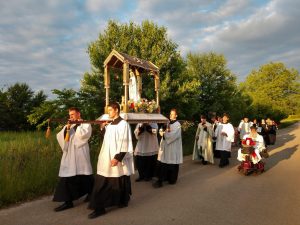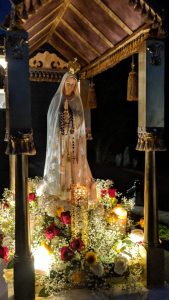
Feast of Our Lady of the Most Holy Rosary
(Excerpts from the writings of Saint Louis Marie Grignion de Montfort)
 Ever since Saint Dominic established the devotion to the Holy Rosary (given to him by Our Lady in 1214) up until the time when Blessed Alan de la Roche re-established it in 1460, the Holy Rosary has always been called the Psalter of Jesus and Mary. This is because it has the same number of Angelic Salutations (Hail Marys) as there are psalms in the Book of Psalms of King David. Since simple and uneducated people are not able to say the Psalms of David, then
Ever since Saint Dominic established the devotion to the Holy Rosary (given to him by Our Lady in 1214) up until the time when Blessed Alan de la Roche re-established it in 1460, the Holy Rosary has always been called the Psalter of Jesus and Mary. This is because it has the same number of Angelic Salutations (Hail Marys) as there are psalms in the Book of Psalms of King David. Since simple and uneducated people are not able to say the Psalms of David, then the Rosary is held to be just as fruitful for them as David’s Psalter is for others.
the Rosary is held to be just as fruitful for them as David’s Psalter is for others.
But the Rosary can be considered to be even more valuable than David’s Psalter for three reasons: Firstly, because the Angelic Psalter bears a nobler fruit, that of the Word Incarnate, whereas David’s Psalter only prophesies His Coming. Secondly, just as the real thing is more important than its prefiguration, and as the body is more than its shadow, in the same way the Psalter of Our Lady is greater than David’s Psalter which did no more than prefigure it. Thirdly, because Our Lady’s Psalter (or the Rosary made up of the Our Father and Hail Mary) is the direct work of the Most Blessed Trinity and was not made through a human instrument.
Our Lady’s Psalter or Rosary is divided up into three parts of five decades each, for the following special reasons: First, to honor the Three Persons of the Most Blessed Trinity. Secondly, to honor the life, death and glory of Jesus Christ. Thirdly, to imitate the Church Triumphant, to help the members of the Church Militant, and to lessen the pains of the Church Suffering. Fourthly, to imitate the three groups into which the Psalms are divided: (a) the first being for the purgative life, (b) the second for the illuminative life, (c) and the third for the unitive life. Fifthly, and finally, to give us graces in abundance during our lifetime, peace at death, and glory in eternity.
Ever since Blessed Alan de la Roche re-established this devotion, it has been called the Rosary. The word Rosary means “Crown of Roses,” or in other words, every time people say the Rosary devoutly, they place a crown of one hundred and fifty-three white roses (Hail Marys) and sixteen red roses (Our Fathers) upon the heads of Jesus and Mary. Being heavenly flowers, these roses will never fade or lose their exquisite beauty.
Our Lady has shown her thorough approval of the name Rosary; she has revealed to several people that each time they say a Hail Mary they are giving her a beautiful rose and that each complete Rosary makes her a crown of roses.
The well-known Jesuit, Brother Alphonsus Rodriguez, used to say his Rosary with such fervor that he often saw a red rose come out of his mouth at each Our Father,

and a white rose at each Hail Mary. The red and white roses were equal in beauty and fragrance, the only difference being in their color.
The chronicles of Saint Francis of Assisi tell of a young friar who had the praiseworthy habit of saying the Crown of Our Lady (the Rosary) every day before dinner. One day for some reason or other he did not manage to say it. The refectory bell had already been rung when he asked the Superior to allow him to say it before coming to the table, and
having obtained the permission, he withdrew to his cell to pray.
After he had been gone a long time, the Superior sent another friar to fetch him, and he found him in his room bathed in a heavenly light facing Our Lady who had two angels with her. Beautiful roses kept issuing from his mouth at each Hail Mary; the angels took them one by one, placing them on Our Lady’s head, and she smilingly accepted them.
Finally, two other friars, who had been sent to find out what had happened to the first two, saw the same lovely scene, and Our Lady did not go away until the whole Rosary had been said.
Hence, the complete Rosary is a large crown of roses, and the Rosary of five decades is a little wreathe of flowers or a small crown of heavenly roses which we place on the heads of Jesus and Mary. The rose is the queen of flowers, and so the Rosary is the rose of all devotions, and it is therefore the most important one.
One day Our Lady revealed to Blessed Alan de la Roche that, after the Holy Sacrifice of the Mass, which is the most important as well as the living memorial of Our Blessed Lord’s Passion, there could not possibly be a finer devotion or one of greater merit than that of the Holy Rosary, which is like a second memorial and representation of the Life and Passion of Our Lord Jesus Christ.
Related Libraries
There are no related libraries
Related Articles
There are no related articles